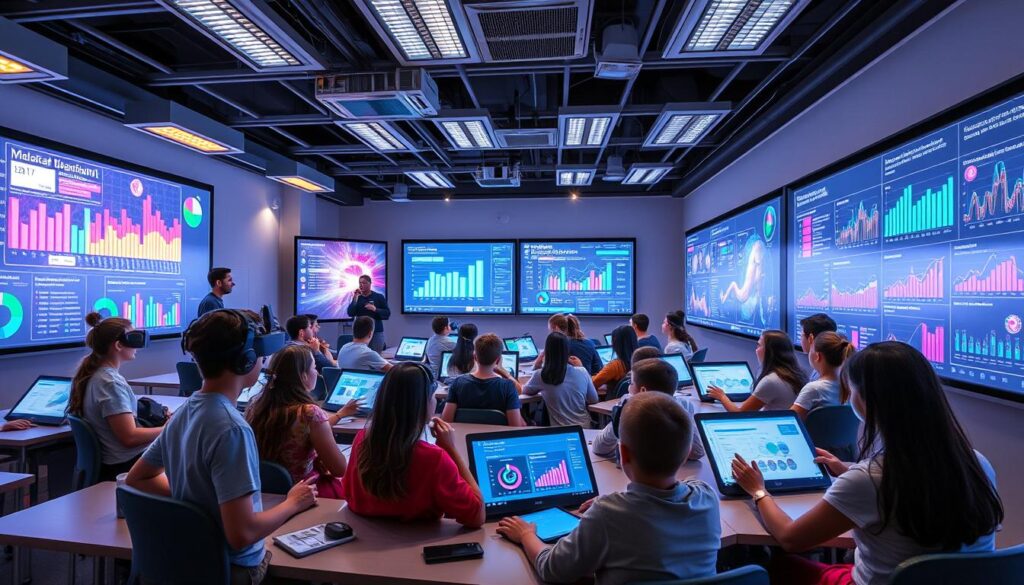המאה ה-21 משנה את תחום החינוך בדרכים גדולות. זה לא רק על לימוד על פי הספר הישן יותר. הטכנולוגיה נמצאת בראש תהליך הלמידה כעת. קיים קפיצת מדרגה גדולה לעבר למידה אישית וכלים חדשים להוראה. אתרים כמו מגזין EdTech ו-Education Week עוסקים בעיקר בשינויים אלה. הם מדברים על איך הטכנולוגיה משנה את החינוך לטובתו. McKinsey & Company גם מביטים במבט עולמי על השפעת השינוי הזה. אנו הולכים לראות כיצד הטכנולוגיה עושה את הלמידה טובה יותר, מעוררת עניין יותר, ובסופו של דבר שונה באופן יסודי.
מסרים מרכזיים
- שילוב הטכנולוגיה מחדש את הפרקטיקות החינוכיות.
- האישיות משפרת התעוררות תלמידים ו-תוצאות למידה.
- כלים חדשים כמו VR ואפליקציות ניידות הם מהפכניים.
- טיפול בבעיות גישה הוא חיוני בעידן הדיגיטלי.
- ניתוחי נתונים משמשים תפקיד קריטי בהצלחה החינוכית.
- העתיד של החינוך דורש איזון בין טכנולוגיה ושיטות מסורתיות.
השפעת הטכנולוגיה על למידה בעידן המודרני
החינוך משתנה במהירות רבה, בזכות הטכנולוגיה. טכנולוגיות חדשות מחדשות את דרכי הלמידה בדרכים שלא חשבנו עליהן. זה לא רק על גאדג'טים חדשים. זה על שינוי דרכי ההוראה כדי לעמוד בצרכי כל התלמידים.
טכנולוגיות חדשות ותפקידן
בינה מלאכותית ולמידת מכונה מובילות את המהפכה הזו. הן מאפשרות למורים להבין כל תלמיד בצורה טובה יותר ולתת תמיכה אישית. הטכנולוגיה הזו עושה יותר מלהפוך את השיעורים למעניינים. היא משנה את החינוך בגורמו העמוק ביותר, עושה ללמידה להתאים לכל תלמיד בצורה טובה יותר.
חוויות למידה אישיות
בזכות ההתקדמויות הטכנולוגיות הללו, הלמידה יכולה כעת להיות עשויה למדי. כל תלמיד מקבל נתיב למידה שמתאים לו, מה שהופך את הלימודים למעוררי עניין יותר. יותר בתי ספר משתמשים בטכנולוגיות אלה, עוזרים לתלמידים לעבוד ביחד, לחשוב בצורה יצירתית ולפתור בעיות.
| טכנולוגיה | השפעה על הלמידה | דוגמאות לשימוש |
|---|---|---|
| בינה מלאכותית | מספקת משוב אישי ומשתנה חוויות למידה | מערכות הדרכה חכמות, צ'אטבוטים לתמיכה |
| למידת מכונה | ניתן לנתח נתוני ביצועים של תלמידים כדי להתאים תוכן חינוכי | פלטפורמות למידה מותאמות כמו DreamBox ו-Knewton |
| מציאות וירטואלית | משפרת חוויות למידה סוחפות | מעבדות מדומות ושחזורים היסטוריים בכיתות |
כלים חדשניים שמשפרים את ההתערבות החינוכית
נוף החינוך תמיד משתנה. זה קורה מכיוון שכלים חדשים מביאים ללמידה יותר עניינית. הם עוזרים ליצור סביבות פעילות ואינטראקטיביות שמתאימות לכל סוגי הלומדים. מציאת וירטואלית מביאה את השיעורים לחיים, גיימיפיקציה מוסיפה כיף לנושאים, ואפליקציות ניידות מאפשרות לתלמידים ללמוד בכל מקום ובכל זמן.
מציאת וירטואלית בכיתות
עם מציאת וירטואלית, תלמידים יכולים לצלול לתוך השיעורים שלהם בדרכים מרגשות. לדוגמה, תלמידי ביולוגיה יכולים לחקור את הגוף האנושי מקרוב. תלמידי היסטוריה יכולים לבקר במקומות עתיקים. סוג זה של טכנולוגיה עוזר לתלמידים להבין יותר טוב על ידי הצגת דוגמאות מהחיים האמיתיים, משהו שספרים לא יכולים לעשות. כלי מציאת וירטואלית עוזרים להפוך רעיונות מורכבים לנוחים יותר להבנה ולזיכור.
גיימיפיקציה של למידה
גיימיפיקציה הופכת את הלמידה לדומה יותר למשחק. גישה זו משתמשת בפרסים ואתגרים כדי לשמור על תלמידים מעורבים. כאשר השיעורים מרגישים כמו משחקים, תלמידים רוצים ללמוד עוד. משחקים כמו Kahoot! ו-Classcraft מפגינים דברים באופן תחרותי, מה ששומר על תלמידים מעורבים ועוזר להם לזכור את מה שהם לומדים. על ידי שימוש
גיימיפיקציה, מאפשרת למורים להעמיק בלמידה ולהפוך אותה לכיף.
יישומי למידה ניידים
למידה ניידת מאפשרת לתלמידים ללמוד בכל עת ובכל מקום שירצו. אפליקציות כמו Duolingo ו-Quizlet תומכות בלמידה מחוץ לכיתות התקניות. הן מציעות שיעורים אינטראקטיביים ומהנים ששומרים על תלמידים שמחים לחזור לעוד. למידה ניידת משתלבת בלוחות הזמנים של התלמידים, ומהווה חלק מהחיים היומיומיים ומתאימה לסגנונות למידה שונים.

| כלי חדשני | קטגוריה | יתרונות מרכזיים |
|---|---|---|
| מציאות וירטואלית | למידה סוחפת | משפר עיסוק, הבנה חזותית |
| גיימיפיקציה | למידה אינטראקטיבית | מעלה מוטיבציה, מחזק שמירה על ידע |
| למידה ניידת | חינוך גמיש | נגיש בכל עת, מותאם לצרכים אישיים |
אתגרים ושיקולים בטכנולוגיית החינוך
טכנולוגיית החינוך נתקלת היום באתגרים ייחודיים. פתרון לבעיות אלו הוא מרכזי להפוך את הטכנולוגיה למערכת תומכת אמיתית ללמידה. ה-חור הדיגיטלי ושמירה על קשב התלמידים הם אתגרים גדולים.
החור הדיגיטלי ובעיות גישה
ה-חור הדיגיטלי מראה כיצד הגישה לטכנולוגיה ולאינטרנט שונה בין התלמידים. ההבדל הזה עושה קשה לחלק מהתלמידים, במיוחד באזורים עם הכנסה נמוכה, לעמוד בקצב בבית הספר. הם נאבקים בלע בלעיים בלעיים ללא הכלים או האינטרנט הנדרשים לשיעורים מקוונים, מה שמשפיע על ציוניהם. הבעיה מגיעה מתוך:
- מחסור ביכולת כלכלית שמונעת רכישת טכנולוגיה
- מגבלות גיאוגרפיות שמונעות גישה לאינטרנט
- חוסר הכשרה טכנולוגית ותמיכה למשפחות

שמירת מעורבות התלמידים
שמירה על עניין התלמידים בעזרת טכנולוגיה יכולה להיות קשה. אף על פי שהטכנולוגיה מביאה דרכים חדשות ללמידה, היא גם מביאה הפרעות. מורים צריכים לעבוד קשה כדי להפוך את השיעורים למרתקים ואינטראקטיביים. הם יכולים:
- להשתמש בטכניקות גיימיפיקציה כדי לשרוד לומדים
- לעודד פרויקטים שיתופיים באמצעות פלטפורמות מקוונות
כדי להפיק את המרב מטכנולוגיית החינוך, עלינו לחצות את הפער הדיגיטלי ולשמור על מעורבות התלמידים.
| אתגר | תיאור | פתרונות אפשריים |
|---|---|---|
| הפרדת דיגיטלית | חוסר גישה לטכנולוגיה בקרב קבוצות תלמידים מסוימות. | ספק תוכניות טכנולוגיה במחיר מוזל; הגברת תשתיות האינטרנט. |
| התעסקות של תלמידים | קושי בשמירה על תלמידים ממוקדים בסביבת למידה דיגיטלית. | יישום כלים אינטראקטיביים; הצעת תוכן רלוונטי ומעניין. |
השכלה מתפתחת דרך נתונים וניתוחים
הנתונים משנים את הדרך בה אנו מודדים ומשפרים את הלמידה בבתי ספר. בתי ספר משתמשים בניתוחי נתונים כדי לשפר את ההוראה, לעקוב אחר הישגי התלמידים, ולוודא שכלי הלמידה מתאימים לצרכי כולם. בעזרת הנתונים, המורים יכולים לראות מה עוזר לתלמידים להתעסק ולהצליח בשיעורים.
שימוש בנתונים כדי לשפר את תוצאות הלמידה
הנתונים הם המפתח לשיפור כיצד התלמידים לומדים. המורים מסתכלים על ציוני התלמידים כדי לראות נקודות חוזק וחולשה. זה עוזר להם לתת את העזרה הנכונה לאלה שזקוקים לכך. בתמורה, כל תלמיד מקבל תוכנית למידה המתאימה לצרכיו האישיים, וכך מתקבלת חדר הלמידה טוב יותר לכולם.
ניתוחים חזותיים בחינוך
ניתוחים חזותיים מראים הרבה פוטנציאל לעתיד החינוך. בתי ספר משתמשים בנתונים מהעבר כדי לנחש מה יצטרך כל תלמיד לאחר מכן. בכך, הם יכולים להתכונן מראש כדי להציע לכל תלמיד חווית למידה שמיועדת רק לו. לדוגמה, על ידי הסתכלות על נוכחות וציונים, הם יכולים לזהות תלמידים שעשויים להישאר מאחור. עם העזרה הנכונה בשלב מוקדם, תלמידים אלו יכולים להתקדם הרבה יותר.
ניתוח תחזיות מוכן לשנות את הלמידה לטובה, צעד אחר צעד.

מסקנה
הנוף של החינוך בעתיד משתנה במהירות גדולה בגלל הטכנולוגיה. זה עושה את הלמידה יותר אישית ומעוררת עניין. חדשנות כמו מציאות וירטואלית ואפליקציות מביאות את השיעורים לחיים.
השינויים הללו משפרים את שיטות ההוראה. הם עוזרים לעמוד בצרכי הלומדים היום.
חינוכנים ובתי ספר צריכים לעקוב אחר השינויים הטכנולוגיים הללו. לקבלת החדשנות זו חיונית. זה מכין את התלמידים לעולם משתנה במהירות.
העתיד של החינוך יצטרך טכנולוגיה ושיתוף פעולה. זה כדי לבנות מקום שבו כל התלמידים יכולים ללמוד היטב.
מנהיגים בחינוך משמיעים תפקיד מרכזי. עליהם לדחוף לגישה הוגנת ולהמשיך להתאים. בכך, בתי ספר יכולים להישאר חזקים בפני שינויים טכנולוגיים.
זה אומר שכל תלמיד מקבל הזדמנות להצליח בעולם של היום.











